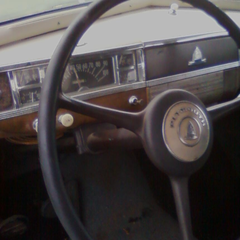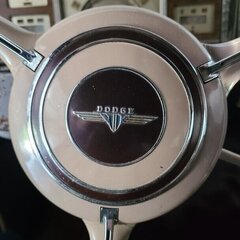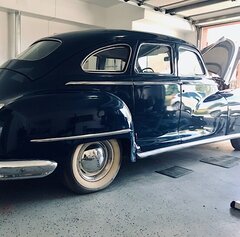
46BulldogDodge
Members-
Posts
24 -
Joined
-
Last visited
Reputation
9 NeutralProfile Information
-
Gender
Male
-
Location
McMurray, PA
-
Interests
antique vehicles and antique furniture; restoration techniques and woodworking
-
My Project Cars
1946 Dodge WC pickup<br />
1957 Dodge WDX Power Wagon
Contact Methods
-
Biography
Retired science teacher, 1946 Dodge WC pickup and 1957 Dodge WDX Power Wagon
-
Occupation
retired
Converted
-
Location
McMurray, PA
-
Interests
Woodworking, gardening, old cars & trucks
Recent Profile Visitors
1,051 profile views
-
ANSWERED Installing horn wire on steering column
46BulldogDodge replied to dgrinnan's topic in Mopar Flathead Truck Forum
One last detail to the bottom…that hole is the end of a small tube that extends above the level of the steering gear lube in the box, making it nearly impossible to hit from above. -
ANSWERED Installing horn wire on steering column
46BulldogDodge replied to dgrinnan's topic in Mopar Flathead Truck Forum
Ivan beat me to it but....Look at the very bottom of the steering box, that's where you should find the hole. Fish a stiff wire up through that hole and out the top. Then attach your horn wire to it and pull the wire back down through the bottom hole. Dick Hultman SW PA 46 WC and 57 FFPW -
78% Nitrogen actually. ? Dick Hultman SW PA 46 WC & 57 FFPW
-
Confused ground short in the rear light wiring?
46BulldogDodge replied to OUTFXD's topic in P15-D24 Forum
Check this recent thread by Tired Iron on the innards of a turn signal switch, should help you understand the wiring a bit. Turn Signal switch inner workings By Tired iron, January 18 -
B1FA serial number decoding
46BulldogDodge replied to ranchracer's topic in Mopar Flathead Truck Forum
I'll be careful here...many have posted over the years about the apparent weakness of the person swinging the hammer on the number dies when these serial numbers were put on the frame...but engine block numbers were usually more regular, at least in a straight line. Just be gentle if you are sanding, scraping when cleaning it. If an "8" were tilted it could show up as a "3". Dick Hultman, SW PA -
If the shoulder of the hole is damaged, you might be able to get away with JB Weld as a sealant when the new plug is installed since the cooling system is not a pressure system. The less chosen, but successful for some guys, method is to use the rubber plugs that expand when you tighten the bolt through them. Even here a little JB Weld around the circumference of the hole could seal the deal.
-
From the "While yur here" category....consider taking out all the others you can easily get to, followed by powerful jets of water from all directions into the holes in combination with wire picks/scrapers. Like the dentist does with your teeth. Leftover casting sand and rust sediment have accumulated for decades clogging up the cooling process. This will be messy...but so worth it for the engine's next 50 years! Regarding leaving it open over winter without water, that would be fine AS LONG AS YOU PREVENT RODENTS FROM GETTING IN THE OPEN HOLES. Best approach would be to install new welch (freeze) plugs and fill with correct water/antifreeze mixture before winter. Prevents further corrosion and lubes the water pump.
-
My mistake....brain fart. Thanks Squirebill for correcting!
-
Bingster, I'm making a WAG (wild a** guess) that your two-hole brass fitting has one line pushing oil to the filter and the other going to the oil pressure gauge. The photo doesn't show much of the "other pipe" in the extreme upper right so I can't speculate on it. However, directly below the brass fitting, obscured by the tube running diagonally, there appears to be a hole. On my block that is where the other oil filter line is attached.
-
The normal...factory setup will have the rotor pointing at 7 o'clock, causing the points to open and fire the spark close to TDC on the compression stroke igniting the fuel/air mixture from the intake. Piston #6 travels up and down exactly in tandem with piston #1 except it is on the exhaust stroke pushing the burned gases out. Since the tang on the bottom of the distributor (looks like a flat blade screwdriver) connects to the oil pump, it can be correct or it can be 180 degrees off. If it's off 180 degrees then #1 cylinder will be at compression when the rotor is at 1 o'clock. This will work but the plug wires must be rotated 180 degrees to match....that would be #1 at 1 o'clock, #5 at 3 o'clock, #2 at 5 o'clock, #4 at 7 o'clock, #3 at 9 o'clock, and #6 at 11 o'clock. If the oil pump is off by a tooth or two when installed, the #1 plug wire location to match TDC compression can be closer to 6 o'clock or 8 o'clock. When you wrote "I put a piece of wire in the pipe hole above #6, turned the fan until the wire stopped rising and kept turning the fan again till the wire stopped rising again. At that point the piece of paper over #1 did move.", you successfully located TDC on #1 compression. This is where the engine needs a spark to ignite the fuel/air mixture and power the piston back down. Dick Hultman SW PA '46 Dodge WC & '57 FFPW
-
Two suggestions...first, the straight pins should be snipped off to a half inch length and pushed into the side gasket and into the end gasket. Just like a nail would hold a board. When the oil pan bolts are torqued, that longer end gasket gets compressed in its track making a tighter seal. Second, regarding sealing compound on the gaskets, others use grease on the block side for easy removal of the pan at a later time and Permatex Red on the pan side. Guide studs, as 9 Foot Box shows, make installation easier by lining things up while you're on your back under the car/truck. I get by with using two studs at the diagonals while I finger tight a couple bolts. Remove the studs as necessary and DON'T over tighten the bolts. Final thought...before reassembly, check the pan surface is really flat. Someone previously may have overtightened the bolts distorting the pan. I use a round drift larger than the bolt's washer and tap the distorted hole perimeters back to flat. I put the pan upside down on my tablesaw for a reliable flat surface. Dick Hultman
-
You can do that....but it might confound the next guy that has to do something with the setup. Sounds like your distributer is 180* out because normally the rotor would point to 7 o'clock when #1 cylinder is at TDC. Pull the distributer and manually turn the shaft 180* and reinsert. Hope this helps. Dick Hultman SW PA '46WC and '57FFPW
-
Vintage Power Wagons has the window channel and other assorted bits & clips. Check also DCM in Michigan. I also dealt with Autoglassics, in Oregon I think, for replacement flat glass and many of the other parts like channel, whiskers, clips, and rubber moulding. They are on eBay. Dick Hultman SW PA '46 WC pickup & '57 FFPW
-
Whiskers are the horizontal pieces at the bottom edge of the opening. Check inside the door with the interior panel (door card) removed. Most 'C' channels continue down into the door in a metal track...at least the truck doors are that way. Hope this helps. Dick Hultman SW PA '46 WC pickup and '57 FFPW
-
R & R speedometer 1945 WC 1/2 ton
46BulldogDodge replied to dmartin_egroup's topic in Mopar Flathead Truck Forum
Some layers of thick cardboard over the seat base make it a lot more comfortable, plus you can slide under the dash and back out. Nut drivers might not reach the nut because they are shallow and access to the nut isn't always straight on. That's why the earlier suggestion was deep socket and flex joint, or even the spring flex connector.





